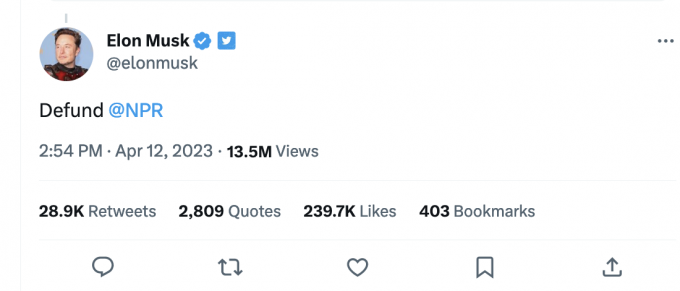May 08, 2023
NPR leaves Twitter
News Takes : Hot Takes | Our Take

Hot Takes
One ongoing story that caught our attention in April was NPR’s decision to stop distributing its news stories on Twitter after Elon Musk abruptly changed company policy and labeled NPR as “State-Affiliated Media.” This was the label previously developed by Twitter’s now-dismantled Trust and Safety Team to warn users about propaganda producers like China’s CCTV, Russia’s RT and Iran’s PressTV.
When we looked at how different news orgs covered this story, the majority of the headlines were similar to what CNBC used: “NPR quits Twitter, becoming first major U.S. news outlet to do so.”
Most of the coverage used the same statements from NPR about Musk’s label being “inaccurate and misleading” since NPR is an editorially independent nonprofit company. In fact, NPR “receives less than 1 percent of its $300 million annual budget from the federally funded Corporation for Public Broadcasting.” NPR CEO John Lansing called for a pause on all 52 of their official Twitter feeds because, “I would never have our content go anywhere that would risk our credibility. At this point, I have lost my faith in the decision-making at Twitter.” When CNBC asked Twitter for a comment, they got a poop emoji in response.
Elon Musk responded to the news of NPR quitting the platform with a two-word hot take: “Defund NPR.” Amplified by the algorithm, the tweet got over 13.5 million views and launched a hashtag that is still generating noise and disinformation. Twitter’s actions speak volumes about the platform’s incentive system and its increasingly antagonistic relationship to reliable news organizations.
In a story by the New York Times, the Global Task Force, a group that represents national public broadcasters in eight countries, reported that Twitter had applied the same “misleading label” “without warning or consultation” to the accounts of the Australian Broadcasting Corporation, CBC/Radio-Canada, the Korean Broadcasting System and Radio New Zealand. The NYT story emphasized the fact the editorial independence of all four broadcasters is protected by law and enshrined in their editorial policies.
After PBS, the CBC and several NPR affiliates paused their content distribution on Twitter as well, the reporting on the ongoing story shifted how Twitter, in response to the backlash, had removed these misleading labels.
Yet further reporting revealed that Twitter had, in fact, removed the label from all media, so that state run propaganda sites like Russia’s RT – which Twitter had previously warned users about - no longer had any label on them. All content creators were effectively lumped together as news organizations with Twitter making no attempt to protect users by warning them about the difference between reliable public interest news and bad faith noise.
Our Take
What Elon Musk’s intention was when he created this noisy news cycle by changing the labels on NPR is unclear, but the response from news organizations that take misleading noise seriously is best summed up by Meagan Kamerick, the News Director at KUNM-FM a public radio station that had also stopped posting content on Twitter: “‘Beware journalism or news media. Your credibility is the only thing you have.” With verification gone and misinformation flooding over Musk’s Twitter, it seems like responsible news organizations have more to lose than gain by providing content for Twitter users to engage with. News that Musk is considering giving @NPR to another company if the actual NPR doesn’t start posting again is further cause for alarm.
Because they do not rely on revenue generated by advertising, Public Media has greater freedom to choose where it distributes its content. In the meantime, the Associated Press, Reuters, and other for-profit news orgs like the New York Times continue to distribute their content through Twitter despite the fact that Twitter accounts for less than 1.5% of referrals for news publishers.
For the moment users should beware, under Musk’s ownership Twitter has stopped taking responsibility for disinformation posted on the platform. It is quickly becoming a place where the “Firehose of Falsehoods” propaganda model that we discussed with Joan Donovan in News over Noise episode 106 is being used by bad faith communicators to mislead and manipulate the public. And until the FTC and FCC holds Twitter to account for failing to protect the public interest, the noise to news signal ratio on Twitter will remain dangerously high.
Contact
News Literacy Initiative
newsliteracy@psu.edu


